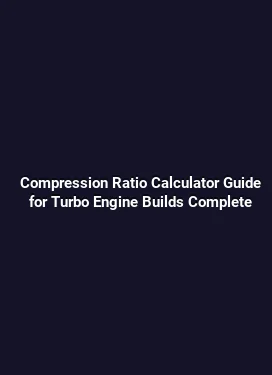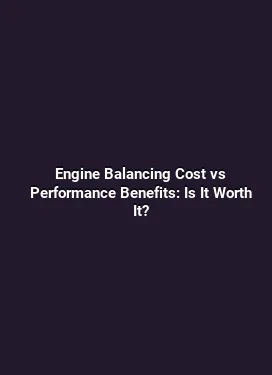Eco-Tuning Explained: Boosting Fuel Economy Without Sacrificing Driveability
In the realm of engine management and tuning, the pursuit of greater fuel efficiency has evolved into a science that respects performance and reliability. Eco-tuning focuses on optimizing how an engine uses fuel and air, how spark is delivered, and how exhaust flows are controlled—without introducing lag, roughness, or reduced responsiveness. This article delves into the core concepts, practical approaches, and real-world scenarios that drive measurable improvements in miles per gallon (or liters per 100 kilometers) while maintaining the character and drivability of modern internal combustion engines.
Foundations of Modern Engine Management and Fuel Economy

Every modern engine relies on an electronic control unit (ECU) that coordinates sensors, actuators, and performance goals. The primary objective in eco-tuning is to align fuel delivery, ignition timing, air handling, and exhaust management with real-time operating conditions such as load, RPM, temperature, and altitude. Key components include fuel injectors, intake and exhaust sensors, ignition coils, cam and crank position sensors, and, in many cases, turbocharging or supercharging systems. By adjusting how these elements interact, a driver can experience more efficient combustion, cleaner exhaust, and smoother power delivery at everyday driving speeds.
Rather than chasing maximum power, eco-tuning prioritizes a balance between peak efficiency and usable response. This often means smoother torque delivery at low-to-mid RPMs, refined throttle mapping for predictable responses, and optimized fuel trims that reduce rich running at highway speeds. The result is not merely a theoretical gain; it translates into tangible fuel savings during routine driving—commuting, errands, and spirited but controlled accelerations on open roads.
Key Concepts in Eco-Tuning Within Engine Management
Understanding the core concepts helps in both evaluating manufacturer strategies and planning safe, reliable upgrades. Several principles consistently appear across diverse platforms and configurations.
Precise Fuel Delivery and Mixture Control

Modern engines rely on two main modes of fuel delivery: injectors calibrated for specific pulse widths and closed-loop feedback from oxygen sensors. Eco-tuning emphasizes fine-tuning injector timing, spray pattern, and fuel pressure to achieve a stable air-fuel ratio close to stoichiometric during cruising, while enabling leaner mixtures at light loads when ambient conditions permit it. This approach reduces excess fuel consumption without risking misfires or catalytic converter overheating.
Practical steps include validating injector flow with a controlled burn test, monitoring short-term and long-term fuel trims, and ensuring fuel pressure remains within designed tolerances across operating temperatures. When done carefully, these adjustments prevent rich conditions that waste fuel and avoid lean hotspots that can cause knocking or detonation under load.
Ignition Timing and Combustion Efficiency
Timing is the spark that ignites the air-fuel mixture. In eco-tuning, the aim is to optimize ignition timing for consistent, efficient combustion across a wide range of operating conditions. This often involves slightly retarding or advancing timing based on knock detection, fuel quality, and engine load, while ensuring that torque remains accessible and transients feel natural to the driver.
Implementation involves analyzing knock sensor data, maintaining a safe knock margin, and leveraging adaptive timing strategies that respond to variations in fuel grade and altitude. The payoff is smoother idle, improved part-throttle efficiency, and reduced tendency to consume extra fuel during acceleration due to overly aggressive timing corrections.
Airflow Management and Turbine Dynamics
Air intake efficiency directly impacts fuel economy. Eco-tuning considers mass air flow (MAF) readings, manifold pressure (MAP) signals, and turbocharger or supercharger dynamics to optimize air delivery. Strategies include reducing parasitic losses, optimizing the throttle response curve, and ensuring boost targets align with fuel availability and engine load. For turbocharged engines, maintaining responsive yet controllable boost at low and mid RPMs is crucial for both driveability and efficiency.
Practically, technicians examine intake tract heat soak, compressor map usage, and charge cooling effectiveness. Improvements often come from cleaner intake paths, properly sized intercoolers, and calibrated wastegate behavior that prevents unnecessary exhaust re-circulation or boost spiking at light throttle.
Practical Approaches to Eco-Tuning in Real-World Scenarios
Translating theory into tangible gains requires a methodical approach. The following strategies are commonly applied across a range of engines to improve fuel economy while preserving or enhancing driveability.
Adaptive Cruise and Real-World Driving Profiles
Modern ECUs can respond to driving patterns by adjusting fueling and timing profiles within safe operating limits. Eco-tuning leverages these adaptive behaviors by selecting driving modes that favor efficiency during steady, low-load cruising while preserving the ability to deliver confident response when the driver requires it. A practical example is programming a mode that uses leaner mixtures at moderate speeds on highways, coupled with smooth throttle mapping to avoid abrupt torque delivery.
Real-world testing often reveals that drivers experience meaningful gains in highway fuel economy when adaptive strategies maintain consistent load and avoid aggressive transitions between gear selections and throttle input. The key is maintaining predictable response while trimming fuel use during light-load operation.
Refined Torque Management and Transmission Interaction
Driveability hinges on how torque is delivered. Eco-tuning can be especially effective when matched to the vehicle’s transmission characteristics. By aligning engine torque delivery with optimal shifting points and downshift logic, a car can maintain steady acceleration with less fuel burn. This requires coordinating engine maps with transmission control logic to minimize unnecessary downshifts and to smooth out engine behavior during load changes.
In practical terms, this may involve retuning shift points for automatic transmissions, adjusting torque converter lock-up strategies, and ensuring that engine braking feels natural without triggering excessive fuel cutoffs or abrupt rev changes. The aim is to keep the engine in a sweet spot where torque is readily available but fuel use remains controlled during responsive driving.
Home-Governed Fuel Trim and Environmental Considerations
Fuel trim adjustments are not isolated to the engine bay. Environmental factors such as ambient temperature, humidity, and altitude significantly influence air density and combustion quality. Eco-tuning practices include calibrating trims to respond to these conditions, ensuring stable operation across seasons and geographies. This often means dynamic adjustments that prevent needless rich or lean excursions, especially during starts in cold weather or at high elevations.
Practical examples include field-testing under varying temperatures and loads, documenting long-term fuel trim behavior, and ensuring compensation strategies do not degrade combustion stability. The end goal is a robust map that maintains efficiency even as operating conditions shift.
Diagnostics, Validation, and Safe Deployment
It is essential to validate any eco-tuning work with rigorous diagnostics. The process typically involves data logging, on-road testing, and controlled chassis dynamometer measurements to quantify improvements. Critical indicators include fuel trim stability, knock events, throttle response, and fuel economy metrics across representative driving cycles.
Diagnostics begin with baseline measurements to understand the engine’s stock behavior. After implementing tuning changes, repeat tests verify that fuel trims remain within acceptable ranges, that no unexpected detonation occurs, and that driveability metrics (such as 0-60 mph times, pedal feel, and smoothness) meet or exceed prior performance. A disciplined validation approach prevents drift over time and protects engine longevity.
Maintenance and Longevity Considerations
Eco-tuning should be implemented with long-term health in mind. Fuel quality, oil condition, and sensor cleanliness all influence how sustainable a tuning strategy is. Regular maintenance—air filter checks, throttle body cleaning, fuel system inspections, and sensor diagnostics—helps ensure that the tuning gains persist and do not come at the expense of reliability.
Additionally, adhering to manufacturer specifications for coolant temperatures, oil pressure, and knock limits is essential. Eco-tuning that ignores these boundaries can lead to accelerated wear, reduced efficiency over time, or, in worst-case scenarios, engine damage. The best practice is a measured approach that respects the engine’s designed operating envelope while extracting efficiency within safe margins.
Case Studies: Realistic Outcomes and Lessons
Real-world examples illustrate how thoughtful tuning can yield tangible benefits without compromising performance. In one scenario, a turbocharged four-cylinder sedan achieved a noticeable improvement in highway fuel economy by optimizing low-load fueling and refining the throttle response. The result was a smoother transition from idle to cruising and a modest but consistent drop in fuel consumption during long trips, all while maintaining confident overtaking capability when needed.
In another case, a naturally aspirated engine benefited from a refined ignition strategy and better intake tract efficiency. The driver experienced improved throttle response at city speeds without a corresponding rise in fuel usage, evidencing that efficiency gains are possible even without turbocharging, provided the air-fuel delivery and timing are coordinated effectively.
These examples highlight that eco-tuning is not a one-size-fits-all solution. Each platform requires a tailored approach that considers the specific sensor suite, airflow dynamics, and transmission behavior to deliver consistent, real-world improvements.
Ethical and Practical Considerations for Enthusiasts
For enthusiasts exploring eco-tuning, a careful, incremental approach is recommended. Start with data-driven assessments, maintain a conservative margin for safety, and prioritize the vehicle’s warranty implications and local regulations. Documentation of all changes, including maps and sensor baselines, supports troubleshooting and future adjustments. A disciplined mindset toward testing, validation, and maintenance ensures that the objective—better efficiency without sacrificing driveability—remains at the forefront.
In summary, eco-tuning marries the science of fuel management with the art of responsive driving. By focusing on precise fueling, intelligent timing, streamlined airflow, and nuanced torque delivery, it is possible to realize meaningful gains in real-world efficiency while preserving the feel and performance that drivers expect from modern vehicles. The journey from theory to road-ready improvements rests on data-driven decisions, meticulous validation, and a respect for the engineering boundaries that safeguard longevity and reliability.






